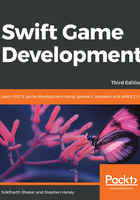
Chapter 2. Sprites, Camera, Action!
We will start our first game by learning how to draw shapes and textures on the screen. SpriteKit makes drawing simple by doing a lot of the hard work and exposing simple classes we can use for rendering. We are free to focus on building great gameplay experiences while SpriteKit performs the mechanical work of the game loop.
To draw an item on the screen, we need to create a new instance of a SpriteKit node. These nodes are simple; we attach a child node to our scene, or to existing nodes, for each item we want to draw. Sprites, particle emitters, and text labels are all considered nodes in SpriteKit.
Note
The game loop is a common game design pattern used to constantly update the game many times per second and maintain the same gameplay speed on fast or slow hardware. SpriteKit wires new nodes into the game loop automatically. As you gain expertise with SpriteKit, you may wish to explore the game loop further to understand what is going on "under the hood".
The topics in this chapter include the following:
- Preparing your project
- Drawing your first sprite
- Animation—movement, scaling, and rotation
- Working with textures
- Organizing art into texture atlases
- Centering the camera on a sprite